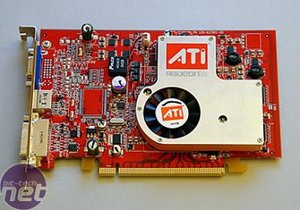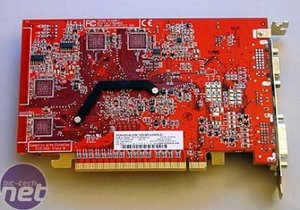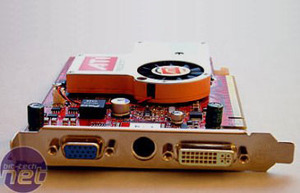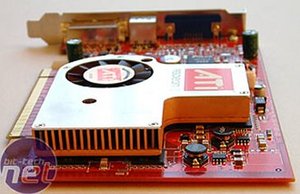
A quick look at the three board's clock speeds and theoretical performance establishes that all three boards may struggle with high-resolution and Anti-Aliasing in the same way that the GeForce 6600GT did. The X700 XT's frame buffer was reduced from 256MB down to 128MB to reflect this - there aren't many titles out there that would fill a 128MB frame buffer before the GPU's fill rate was exhausted. We think that this is a sensible decision, as it reduces the cost of the X700 XT.

As we've already mentioned, the RV410, or X700 series is exclusive to PCI-Express at the moment. With this in mind, you notice that there is no external power connector on the board - the boards' power requirements are under the 75W that the PCI-Express x16 slot can provide. We estimate that if there is an AGP version of this board at a later date, there will be a requirement for an additional source of power to the board.
The heatsink is a copper design with an aluminium shell - there are more images of the heatsink detail further down the page. The fan, however, isn't quite as quiet as the one that can be found on a GeForce 6600GT. Quite often during our testing, the fan went in to its full speed mode, which is slightly louder than what we are used to - we could certainly hear the fan above the other case fans and CPU fan inside our PCI-Express test system when it was running at full speed. There are four BGA memory chips located underneath the heatsink - these are not in direct contact with the heatsink as they're 2.0ns GDDR3-based chips, which run with considerably lower voltage specification than either DDR or GDDR2.


Interestingly, we can see that the PCB was designed to support 8 BGA memory chips and up to 256MB of GDDR3 memory - there was initial plans to ship the X700 XT with a 256MB frame buffer, but we honestly don't think that there's a considerable need for this extra memory on a graphics board with a relatively low peak memory bandwidth. Certainly when titles start to support 3Dc, the performance gained by the X700 XT should outweigh the need for the extra 128MB frame buffer.


These two photos show the detail of the heatsink design, which is a bi-metal construction. The shell is made from aluminium, while the part that is in direct contact with the core is made from copper. The photo on the left also details the blanking plate arrangement: there's the standard VGA and DVI ports, and also the inclusion of a HDTV in/out port (VIVO) which has full common mode support for EIA 861B timing specification, along with support for 256 byte E-EDID and CEA timing extensions and non-common modes through intelligent mode selection and parameter determination.

MSI MPG Velox 100R Chassis Review
October 14 2021 | 15:04






Want to comment? Please log in.